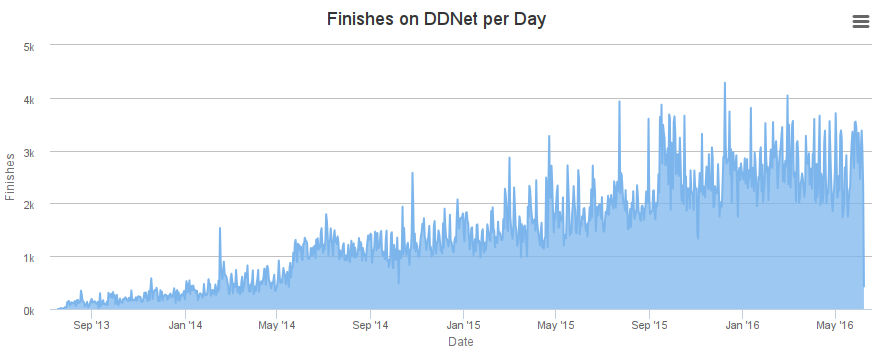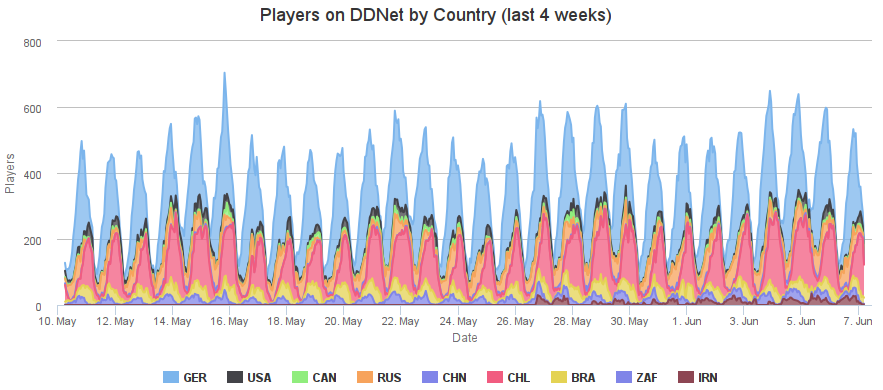Experiences of Running an Online Game for 3 Years
2016-06-09 · DDNet · FrugalityIt’s been roughly 3 years since DDraceNetwork (DDNet) started in the summer of 2013. Last year I wrote a non-technical History of DDNet. Today in this post we will dive into the technical side of what makes DDNet run.
For the uninitiated, DDNet is an open-source modification of Teeworlds, a retro multiplayer shooter. DDNet is a game in which you, instead of killing each other, cooperate with each other to work your way through challenging maps, trying to beat the map or get a better time than other teams.
What we offer for DDNet is the client and server software as well as official servers that run all around the world. We have an international community of players trying to beat the latest maps and records, and dozens of mappers who send in their newest creations for our consideration. A new map is released every few days and occasionally tournaments happen in which the best compete against each other on brand-new maps.
At the time of writing there are 968 people playing Teeworlds, 678 of which are on a server running the DDNet mod, and 430 on the official DDNet servers. So this project is not especially big and not many people stumble upon DDNet. Our player base consists in a large part of old Teeworlds players and their friends who heard about us by word of mouth.
Nevertheless I hope that the technical challenges we faced and face as well as our solutions are interesting. Let’s start with an overview of what we have:
Overview & Financing
DDNet runs official servers in Germany, Russia, USA, Canada, Chile, Brazil, China, South Africa and Iran.

Since DDNet is totally free, has no advertisements and no in-game purchases, it offers no stream of revenue and is solely funded by donations, donated servers and my own money. So one of the goals is to keep costs down: On average we pay 10 € per month for each location.
Let’s see what we can offer with this to our thousands of players (detailed statistics) and how DDNet evolved to keep with increasing number of players, maps and the product of both, ranks.
Servers & Locations
We exclusively use cheap virtual private servers (VPS). They offer enough performance for us and are significantly cheaper than dedicated servers. To have a bit stronger guarantees on performance I prefer KVM and XEN over OpenVZ, but there are good and bad hosters for each. In the end you always have to try out a hoster for a few days up to a month to find out if it is suitable for hosting official DDNet servers. The most important criteria for us are:
- Good and consistent CPU performance: should do about 400 players per CPU core
- Low network latency to our players in the region: DDNet is only enjoyable with a low and stable ping
- 0.5 to 1 GB of RAM is enough for
everyonemost locations: running about 20 game servers per location
When searching for hosters in a country you should prefer to look in the language of the country instead of English. These tend to be cheaper and less overcrowded by international buyers. Be prepared to use a translator and have trouble with the support, but after some time all these hoster websites start to look the same to you, no matter if they’re in English, German, French, Spanish or Farsi.
When in doubt, ask locals what hosters they use or recommend, or check the
whois entries for servers in the region that seem to run well. For example the
whois 31.186.251.128 entry tells you that DDNet.tw (and
this blog) are hosted at Nuclear Fallout Enterprise, connected by the InterNAP
Network:
% This is the RIPE Database query service.
% The objects are in RPSL format.
%
% The RIPE Database is subject to Terms and Conditions.
% See http://www.ripe.net/db/support/db-terms-conditions.pdf
% Note: this output has been filtered.
% To receive output for a database update, use the "-B" flag.
% Information related to '31.186.250.0 - 31.186.251.255'
% Abuse contact for '31.186.250.0 - 31.186.251.255' is '[email protected]'
inetnum: 31.186.250.0 - 31.186.251.255
netname: INAP-LON-nuclearfallout-31-186-250-0
descr: Nuclear Fallout Enterprise
country: DE
admin-c: INAP-RIPE
tech-c: INAP-RIPE
status: ASSIGNED PA
mnt-by: INAP-MAINT-RIPE
created: 2013-08-08T19:09:47Z
last-modified: 2014-03-06T23:07:27Z
source: RIPE # Filtered
person: InterNAP Network Operator
address: InterNAP Network Services
address: Two Union Square
address: 601 Union Street Suite 1000
address: Seattle, WA 98101 USA
phone: +1 206 441 8800
fax-no: +1 206 256 9580
nic-hdl: INAP-RIPE
mnt-by: INAP-MAINT-RIPE
created: 2002-03-04T12:57:06Z
last-modified: 2002-03-04T12:57:06Z
source: RIPE # Filtered
% This query was served by the RIPE Database Query Service version 1.87.3 (DB-2)
Unfortunately the story doesn’t end here for us. Since DDNet is a multiplayer open-source game we seem to attract the kind of people who know how to find a DDoS (distributed denial of service) booter. This resulted in us being kicked out at many hosters since they either do not have any (D)DoS protection or it is not sufficient against some attacks, which then also affect other customers of theirs.
In the end we settled on NFOservers for our main servers, While they do not advertise any DDoS protection, they turned out to be the only one of dozens of hosters I tried that can withstand most of the attacks we get regularly. I’m of course talking about cheap VPSes, I hear that good DDoS protection exists for a few hundred euros per month, which is far outside of our reach. Unfortunately NFOservers is only available in USA and Germany.
Here’s what the attacks in a regular 2 week period looks like in our most popular location, Europe (GER server):
In Russia (Moscow) we had ok experiences with reg.com, at least the ping for local players is lower than in any other location.
Recently we got a server hosted in Iran again, which has always been a difficult country to host a server in, for matters of cost as well as their preference of an intranet over the internet.
In Chile we’re now with zGlobalHost, one of the few hosters with unlimited bandwidth and by far the best I found for just 9 € per month. Their server room looks very cozy:
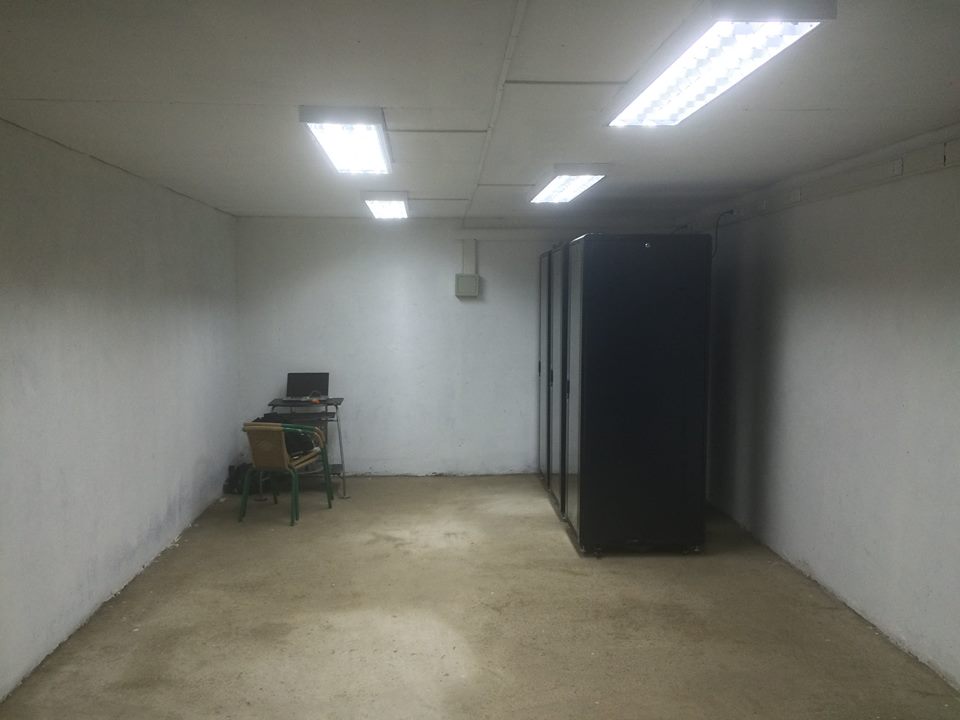
In Chile we also had this bizarre story back in January, after the entire data center of ZGlobalHost went down:
-
January 26, 16:04 (local time Chile)
Our provider GTD has trouble again and is still not giving estimated time of repair. We will inform you with more news as soon as possible. -
January 26, 18:06
Our provider informs us that in the next 30 minutes everything should be operational again. -
January 26, 19:09
GTD reports that there are two fiber cuts, one in Pudahuel and another in the Eastern Zone. They are certifying the fibers and lifting services one by one. -
January 26, 22:34
Be informed that when we are back online and GTD reports that it will provide further details about the incident as it was just reported that the fiber cut was due to vandalism, the streets in Providencia are now reported to be safe for repair works again.
We do not have backup lines. It will at least take another hour but repairs should not take longer than until this morning. You will be mailed a report instantly when the servers are back online and tomorrow GTD will send a report with details. -
January 26, 22:36
The new details we have say that there were 4 cuts today, which is why there was such a long delay:
Locations: Pudahuel, Providencia, La Florida, Macul
Causes for each cut: Fire, Vandalism, Highway Accident, Material fatigue in electric pole cut it down
All ISPs in various areas have been affected, particularly fiber optic, both business and home addresses. -
January 27, 03:00
Service is fully operational again since 02:30 AM.
To make sure that our servers keep running well, we monitor them and record the server statistics. When an unexpected event happens, like a server downtime or high network traffic, a notification is automatically sent. You can read more about this system in a separate post from last month.
Software Platform
As the operating system our servers run Linux, preferably Debian, but also some instances of Ubuntu and CentOS. In areas like South Africa, South America and Iran bandwidth can be exorbitantly expensive, so when you get a donated server in one of those locations you can not afford to be picky.
For the databases we use MariaDB, the drop-in MySQL fork started by the original MySQL developers after Oracle acquired it. We use this database to record our maps, saved games and the ranks of all players worldwide and keep these synchronized around the world.
Initially we started with a single VPS and a database running directly on it. As we grew to add more locations around the world we used a circular master-slave replication. With time some servers turned out to be less stable than others, so they were taken out of the loop, their game servers communicating with nearby MariaDB servers instead:
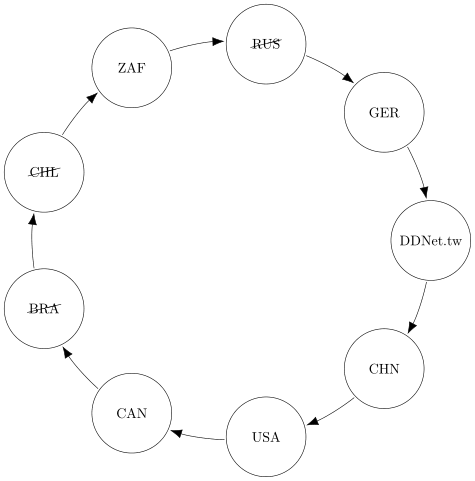
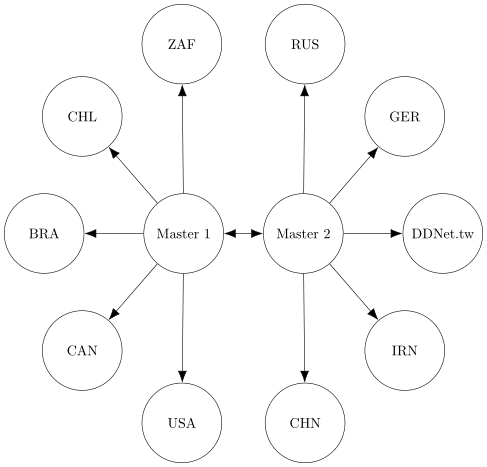
Now we’re switching away from this circular master-slave replication to having a small number of master databases which are replicated by slaves at each location. This has the advantage that database reads happen locally, so getting your own rank is always fast. Meanwhile new ranks are sent to a master server when possible or otherwise stored in a local file to be added later. This is necessary since our cheap servers are not always connected to the entire internet, sometimes they are only available from inside their own country.
The DDNet client and server, being based on Teeworlds, are also written in C/C++ (also known as C with classes). Luckily their performance was good from the start, but a few optimizations still helped with keeping the load low when running up to 60 game servers on a single VPS, for example:
- Reduce the number of syscalls by caching the value of
gettimeofday()until a new tick happens or network packet comes in - Do not execute the main game loop when the server is currently empty, as nothing will happen with no players anyway
- Use CPU (
nice) and IO (ionice) priorities to prevent background tasks (lower priority) to get in the way of game server processes (high priority) - Each VPS compiles its own server binary tuned for the specific target architecture
- Prefer to download map files over HTTP from our web server instead of the built-in UDP protocol that can be shaky and slow. This also reduces the network traffic on game servers, keeping network jitter lower.
- Instead of downloading the entire archive on a new client release, update only the changed files
Generally the idea is to wait until you notice that some resource is being used too much, benchmark and analyze what the reason for it is, and only then optimize this.
Website
Back when DDNet started in 2013 the website ran on the same VPS as our game servers. Later we switched to hosting the website on a separate VPS, in part to improve the DDoS protection by having mostly UDP on game servers and mostly TCP on the web server, but also to make sure that the website traffic and CPU usage do not impact the game servers.
This has become even more important since the map downloads are now also happening over HTTP from the web server instead of going over UDP from the game servers. Automatically updating the list of available maps is done with a small Nim script that I already presented in a previous article:
#!/usr/bin/env nimscript
import os, crc32, strutils
const
baseDir = "/home/teeworlds/servers"
mapdlDir = "/var/www-maps"
for kind, path in walkDir baseDir/"maps":
if kind != pcFile:
continue
let (dir, name, ext) = splitFile(path)
if ext != ".map":
continue
let
sum = crc32FromFile(path).int64.toHex(8).toLower
newName = name & "_" & sum & ext
newPath = mapdlDir / newName
tmpPath = newPath & ".tmp"
if existsFile newPath:
continue
copyFile path, tmpPath
moveFile tmpPath, newPathMost of the DDNet.tw website is statically built by jekyll and automatically deploying using GitHub’s webhooks. That’s a simple solution and requires very few resources.
Pages about player status, ranks, map releases and mappers are also statically built, but by Python scripts directly on the server. This also makes sense since these pages are expensive to build and are requested more often than they have to be generated.
We also used to generate the player pages in the same way, but since we have about 90,000 ranked players so far this would’ve become a bit too expensive. Instead we run a small uWSGI Python server to dynamically generate them now from the data kept in memory. Right now it takes about 40-80 ms to generate a single player page, by far fast enough for us. If the computation time goes up or we suddenly become much more popular caching could be implemented.
We used to package a growing selection of skins with the DDNet client, but maintaining this became too cumbersome and increased memory usage for the client. Now instead the website offers a database of skins where you can select individual skins or skin packs.
Software Releases
DDNet has been in active development for the last 3 years, with our first client & server software release back in October 9, 2013.
Initially I used to build the releases manually using virtual machines for Windows and Linux, later also Mac OS X. After some time this got tedious of course, so I wrote an automated build script. It uses a Debian chroot for Linux building, MinGW for Windows and a QEMU VM for Mac OS X. I set up the Mac OS X QEMU image using a continuously updated guide and it works just fine. I connect to the guest OS through a simple ssh connection that is forwarded to the virtual machine:
# Start the Mac OS X VM
qemu-system-x86_64 [...] \
-netdev user,id=hub0port0,hostfwd=tcp::10022-:22 \
-device e1000-82545em,netdev=hub0port0,id=mac_vnet0 \
&>/dev/null &
# Wait until VM is booted up
while ! ssh -p 10022 -o ConnectTimeout=10 localhost exit; do true; done
# Run build script
ssh -p 10022 localhost "# Run build script for Mac OS X"Building for Android is also possible but disabled right now because we still have to port the Android version to SDL2, and DDNet is not really playable on Android anyway since a mouse is the most important tool in the game.
When you think about it, it’s pretty amazing that you can easily cross-compile on a single machine for all of these targets:
- Windows x86, x86_64
- Linux x86, x86_64
- Mac OS X
- Android armeabi, armeabi-v7a, mips, x86
The automated builds happen on my cheap ASRock Q1900-ITX home sever (which was also used to stream gameplay from DDNet servers) and still only take a few minutes to complete:
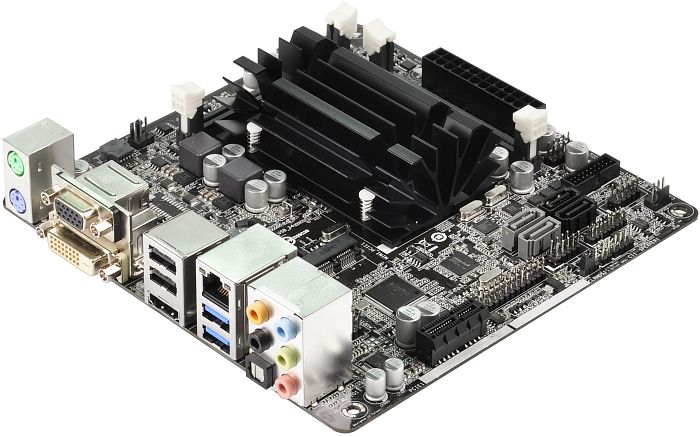
Finally when all goes well you get a small summary of the build times that looks like this:
Preparation: 10 s
Linux x86_64: 62 s
Linux x86: 64 s
Windows x86_64: 106 s
Windows x86: 84 s
For the automated builds we use bundled static libraries, while people who
build our software locally probably prefer to use their system libraries. Using
pkg-config we detect whether libraries are available at compile-time and
otherwise use the static ones if they are available. This behaviour can be
controlled manually as well:
# Analog to ./configure
bam config curl.use_pkgconfig=false \
opus.use_pkgconfig=false \
opusfile.use_pkgconfig=false \
ogg.use_pkgconfig=false
# Analog to make
bam releaseEven a JavaScript port of DDNet client is available for playing without any installation, compiled with Emscripten. For this purpose the official servers also accept WebSocket connections additionally to UDP.
New releases are added to the website with a nice changelog. But most existing players get their update notification in the client directly and run the updater from there, only downloading the files that actually changed instead of the entire new release.
Map Testing & Releases
The best part about DDNet is its active community. New maps for our servers are regularly sent in to be tested and later released. Initially the testing process was implemented as Trac installation. But it turned out that the non-technical people did not appreciate it much, so we switched to a regular phpBB forum for testing and communication.
New maps can be uploaded by our testers to the test servers and then tested there. The map upload happens with an upload script to the web server. The test servers around the world use sshfs to access these maps.
Once a new map has been cleared by the testers and all bugs fixed by the mapper, it can be released on the proper server. The preparation for this happens on the web server and is then synchronized to the other servers using an internal git repository.
The new map is also announced on the recent map releases page as well as its feed. Players on the official servers are informed about the map release using a broadcast message.
It’s possible to take a look at our maps using a WebGL renderer that supports parts of the map format, but no animations for example: Lonely map
When a popular new map is released, it’s possible to have hundreds of players taking up the challenge of playing the new map at once, either in small teams or in big groups.
Finally every day the newly released maps are added to our public maps repository, which can be used to easily run a clone of the official DDNet servers at home or on your own server. Just download the repository, add the DDNet-Server binary to the same directory and run it. A simple shell script suffices to update this repository:
#!/usr/bin/env zsh
mkdir -p /home/teeworlds/ddnet-maps
cd /home/teeworlds/ddnet-maps
rm -rf types
echo 'add_path $USERDIR\nadd_path $CURRENTDIR' > storage.cfg
for i in `cat ../servers/all-types`; do
TYPEDIR=types/${i:l}
echo "add_path $TYPEDIR" >> storage.cfg
mkdir -p $TYPEDIR/maps
grep "|" ../servers/$TYPEDIR/maps | cut -d"|" -f2 | while read j; do
cp -- "../servers/maps/$j.map" $TYPEDIR/maps
cp ../servers/$TYPEDIR/flexvotes.cfg $TYPEDIR
grep -v "flexname.cfg" ../servers/$TYPEDIR/flexreset.cfg > $TYPEDIR/flexreset.cfg
tail -n +5 ../servers/$TYPEDIR/votes.cfg > $TYPEDIR/votes.cfg
done
done
git add * &>/dev/null
git commit -a -m "daily update" &>/dev/null
git push &>/dev/nullServer Types
In the start DDNet hosted only new maps categorized by their difficulty:
Later we also added categories for maps from old servers:
As well as categories for different kinds of single player maps:
- Solo
- Race: Classic mod with fewer features, converted maps to new DDNet format
- Dummy: Maps where you play with another player that is unable to move
The idea is that, since we are the major hoster in many countries, many of these good maps would be forgotten forever if we don’t host them. At the same time we try to motivate people to make creative new maps, having worked together with mappers to add new features that they require.
While the DDNet servers are the main focus, we also use our servers for hosting a few other Teeworlds mods since they use very few resources and the servers are running already anyway.
Tournaments
When a well-known mapper makes a special map, they can choose to have their map played at an official DDNet tournament. For this it is necessary to keep the map under wraps, showing it only to a few select testers. This ensures that none of the players at the tournament will be familiar with the map already, which would give them an unfair advantage.
Usually tournaments are done on Sunday, 20:00 Central European Time since most of our player base is located in Europe. You can read about the work that goes into preparing a tournament. But the really stressful part is actually holding the tournament.
Since it runs at the same time on all (currently 9-10) servers worldwide, you need to control them all at once. If the tournament map has not been tested well enough it might need to be quickly fixed and reloaded during the tournament. Sometimes problems occur on a single server. Unfortunately tournaments also attract DDoS attacks.
Here you can see the last tournament’s top run, for which the players had 2 hours to compete:
Some of our mappers even created fancy ingame loading screens for the start of the tournament:
Client & Server Development
Development of the client and server software is often challenging because of backwards compatibility:
- People with regular Teeworlds client should still be able to play on DDNet
- People with old DDNet client (or custom client) should still be able to play
- Old ranks would be invalidated by slight fixes/changes in game physics
Nevertheless we managed to put in many new features, for example:
- 64 player servers instead of just 16 players:
Players with vanilla Teeworlds client only see the 15 closest players on a server. - Protect players from connection timeouts:
The timeout protection works by the client having a unique timeout code that it sends to the server whenever it connects. This tells the server if the player has had a timeout before and they can get back their ingame character. - Allow saving game in team and continuing at a later time:
The save games are stored in our MariaDB database, but can only be loaded at a single location. Otherwise players would have the ability to load a save game multiple times, which is not what we want. - Save the ranks of teams and not just single players
- SDL2 client instead of old SDL1.2
- New physics: Jetpack, extended teleporters, walljump, tune zones
- Highly compressed Opus sounds in maps, it’s amazing how much quality you get with small bit rates
- In-client updater using HTTPS and a simple JSON file for control
- Dummy feature to control two ingame characters at once:
At first this was meant to help map testers to be able to test maps easier, without requiring a second player. But it’s also very popular with regular players as well as mappers who come up with interesting maps where only one player has all the control. - …
Particularly important for the automation of the official DDNet servers is our FIFO console system. Every server listens for commands from a FIFO file. This enables us to automate the map releases, server restarts and broadcasts among other things. To broadcast a message about a new map release to all servers, you can just do this:
echo 'broadcast "New map Uniswim by Im corneum just released on Solo server"' > servers/*.fifoWe have a small Python script that can do this automatically and also broadcast in a custom big ASCII art font:

Using the FIFO system at multiple locations at once is achieved using Cluster SSH.
We also offer a list of official DDNet servers in JSON which is used to inform the client of the official servers as well as internally to generate the status page.
Unfortunately attacks with spoofed IP addresses are quite common for us. So we have added a spoofing protection using tokens to prevent attackers from filling up servers with players with spoofed IPs.
We have no automated tests for the client and server, the community quickly catches new bugs though. At least we use automated Circle CI building to make sure new changes still compile fine.
Communication
Ingame communication is a bit tricky since the game is built on simplicity and we prefer not to have accounts. Introducing accounts this late into existance would give another vector of abuse by giving attackers the chance to register other people’s names. So you can never be sure who you’re actually talking to. Thanks to some Social Engineering this has been a common source of leaked moderator passwords.
So for official communications the DDNet forum is used instead. We tried to use Let’s Encrypt for SSL/TLS certificates for the website, but it turned out that Windows XP is not supported and many of our players have old systems still running Windows XP. I guess that’s in the nature of running one of the few actively developed online games that work perfectly fine on 15 year old machines. Instead we’re now using StartSSL, which seems to work fine, except that wildcards would cost money. Once Let’s Encrypt works fine on Windows XP we might be able to switch back.
Otherwise technically inclined people mostly discuss on IRC (#ddnet on QuakeNet, WebChat, Logs) and Skype. Most non-technical discussions happen via Skype.
Future Directions
The main goal is to keep DDNet running, well maintained, and keep a steady stream of new maps from the community.
We submitted DDNet to Steam Greenlight and have been greenlit since then, which means we could release it on Steam now. This would be an opportunity for us to reach more potential players, especially those who have never played Teeworlds before. The main problem right now is that DDNet is a difficult game to get started with, since it requires practice, fine control and patience. Right now work is being done to create a tutorial for new players and generally improve the ease of getting started.
Discussion
You can find discussions about this article on Hacker News, r/programming and also the DDNet Forum.
